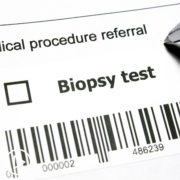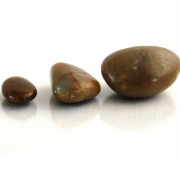What Can I Expect During a Bone Marrow Biopsy?
What Can I Expect During a Bone Marrow Biopsy? from Patient Empowerment Network on Vimeo.
Myeloma patient advocates Lisa and Sujata share their experiences with bone marrow biopsies – what to expect and how to prepare.
See More from START HERE Myeloma
Related Programs:

|
Transcript:
Sujata Dutta:
And then there was one more thing that you spoke… When we started with the conversation, BMB. Let’s talk about BMB the dreaded swear word.
Lisa Hatfield:
It is next to dex. I think it’s the second. Maybe it’s equal with Dexamethasone, people talk about dex being the worst thing about myeloma, the BMB, the bone marrow biopsy. Yeah. Did you have one? Right when you were diagnosed?
Sujata Dutta:
Yes, and it wasn’t a pleasant experience. I was obviously, as I mentioned, I had a surgery an emergency surgery, it was pretty… It lasted for six hours and I was wrapped up in all sorts of things, and then I had to have the BMB while I was on an ICU bed, so… Totally not in the best place to start, and it was the first time I was going to have it. So it wasn’t a pleasant experience. It was super painful, they could not sedate me for obvious reasons, because whatever was going on, but post that I had the next BMB, I’ve had a couple… I’m not sure that’s a good thing or a bad thing, the next one, I had it in Mayo and I learned that I could actually be partially sedated and so I wouldn’t feel anything, which was like, Oh my gosh, I thought that was the best discovery mankind had ever made. And ever since then, I’ve always requested for being seated through that process, because otherwise it can be really, really painful, so I don’t know if you want to talk about what the procedure is. I am going to assume some of the folks here have been through this, unfortunately.
Lisa Hatfield:
Yeah, because the bone marrow biopsy is the only way to actually see the myeloma cells, the cancerous plasma cells, it is necessary, it’s also necessary to get it done so they can diagnose the genetic abnormalities, the cytogenetics. But yes, I actually had a little bit different experience. So again, every patient is so different, I prefer not to be sedated because I don’t like sedation, I don’t like the way I feel, I don’t feel good when I have it, so I did have it done and I was… Where I went the first time they didn’t offer sedation, it was, this is 20 minutes, and it wasn’t comfortable.
I will admit that I didn’t like the worst part for me was when they numb the area with lidocaine, they gave you the little shots before they do that, so I’ve had six of them total now, but I’ve had the most recent one. The sixth one I had, they did sedate me and I think it’s conscious sedation, so it’s like you said light sedation, I don’t remember any of it, but I didn’t like it because I had two days of recovery from the anesthesia, so… Yeah, so I think the…
Going back to somebody who’s maybe anticipating it for two nights straight, I couldn’t sleep, I was so nervous about the bone marrow biopsy, I just thought This is going to be so painful. I had excruciating pain in my spine anyway, ’cause it was collapsing as I was going through, I had radiation first, so the bone marrow biopsy didn’t seem to affect me quite as much the first time, but this last time, it seemed to be a little more uncomfortable, especially afterwards, but from my understanding from the bone marrow biopsy, they go in either with the needle, basically the thick needle or where you go to the Mayo Clinic in Scottsdale uses as a drill, and I guess that’s supposed to be faster, and a lot of people think it’s more comfortable, go into the bone marrow and try to take some of that bone marrow out… The soft part of the bone out, they actually take two different samples, but I think the most, uncomfortable part if you’re not sedated, I think is that vacuum-type feeling, and then there’s like a pop… And that was super uncomfortable. I thought that was probably the worst part of not sure if it’s pain or discomfort or what, but I do remember that looking back though, now, every time I’ve had one, I always say that wasn’t so bad.
I remember it, but it wasn’t… I don’t remember it being too bad, so what they do is they will collect enough… They usually have a lab person available as they’re to make sure that they have enough of a sample and the right… The right cells and enough of it, so they usually will only go in once I had one where they had to go back in a second time to try to aspirate some more… The bone marrow, they’ll look at that takes a few days to go through the lab and look at that and see what your genetic abnormalities are with the myeloma cells themselves, and what the volume of cancer cells is in your bone marrow.
But yeah, I just remember, either way, if you’re sedated, you don’t feel it at all while it’s happening, if you’re not sedated, you can feel, especially when they’re numbing it up, the lidocaine shots and that stings, it’s a sting three or four times and takes a little time for it to set in, and then that suction that pop, that’s what was the most uncomfortable, and I think that really the most pain that I felt was the bruise-like pain, the couple of days afterwards, they’re not walking, but just sitting on it is bandaged up really…
Well, you can’t take a shower for a day, but when I would go to sit on it, it just got bruised, but… Yeah, the bone marrow biopsy, nobody looks forward to those… It’s nice to know that there is something in the works, even mass spec testing, which isn’t quite as sensitive… It’s nice to know that there’s something that works, to maybe look at other ways to test for the myeloma. Yeah, not fun. It’s a necessary thing though that when people are diagnosed with multiple myeloma.
Sujata Dutta:
That’s absolutely the true statement. I don’t like it at all. I am also anxious before I have my… I’ve had four now, so… And every year I’ll have to have one, so I know that that’s a necessity, as you said, I do feel anxious, but I keep telling myself this is needed to assess overall disease involvement and hopefully the results are better than last year, so I kind of… That’s how I sort of create some positive energy around that experience because it’s not a pleasant experience, and as you said, it does hurt for a couple of days after I actually have… Sometimes it goes on for a week that I have, or discomfort, but again, each to his own people might have different experiences, but I think the more we talk about it, the more we hear other people’s experiences, we might just feel like, Hey, mine was not all that bad, I look at her, him, what they’ve gone through and things like that, or even just thinking like… It’s different, it’s nuance.
Everybody goes through different experiences like you prefer not being seated, I prefer being sedated, so it depends on each one’s experiences, but the bottom line is there are options available, everybody understands, it’s a difficult procedure, everybody understands it’s not pleasant, nobody wants to put the pain through that if they had a choice.
Right now, we don’t have one, so I think just thinking about in a positive way and embracing it, I guess might just help, it helps me, so I’m hoping that it helps others as well, just changing the perspective a little bit.
Lisa Hatfield:
Yes, so who does your bone marrow biopsies? I’ve been to… Sometimes a nurse practitioner does them and sometimes an RN does mine, and I know some of our local doctors do them, oncologists do them, what type of professional does your bone marrow biopsies?
Sujata Dutta:
With Mayo, I’ve had it twice there, they have specialists, they have a whole team that does obviously Mayo, they do like MM treatments, like they have 500 patients doing biopsies every year. That’s what I heard. I had mine there too, so it’s a well-oiled machine, they just have departments for every little thing, so that’s different, but even when I do it with my local cancer center, they have a specialized team, so it’s not the nurses, there’s a specialized team. There’s a different procedure.
Again, it’s different to how Mayo does it. When I do it at my cancer center, they actually do a scan before I have a BMB, and to make sure that they’re going in the right place. Which I thought like Wow, that’s great. Just as a second level of precision, but yes, that’s different to Mayo, but it’s always like a specialist doing it for me.
Lisa Hatfield:
Yeah, and then how often do you have to have those on a regular basis, like annually or just as things change with treatment?
Sujata Dutta:
Annually. So, only just… Obviously, for my diagnosis I had that and then six months later, and I had a stem cell transplant and I did a BMB prior as well then, a couple of months after I did that again. So that was the only time and it happened more regularly, but since then it’s been like yearly.
Lisa Hatfield:
Yeah Okay. Yeah, the bone marrow biopsy is interesting because I know a lot of… There’s different ways that they test that and now they have a more sensitive test, so everybody has different..That’s the other part of alphabet soup. Some people have something called flow cytometry or NGF or NGS. So anyway, yeah, it’s kind of interesting that everybody will have different ways of going through that or different experiences, so anybody who has questions, you’re welcome to reach out to me at PEN or any of the other resources that are out there.











